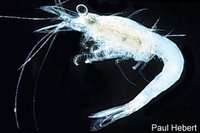
(Source: Biodiversity Institute of Ontario)
| Malacostraca | ||
| Arthropoda | Mysida |
| Arthropoda | Peracarida
└─► |
|||
| Ostracoda | None |
Decapoda |
|
Abbreviated Dendrogram
Crustacea
├─Phosphatocopida
└─┬─Branchiopoda
├─Remipedia
╘═╤═Maxillopoda
├─Ostracoda
└─Malacostraca
├─Phyllocarida
└─┬─Hoplocarida
└─Eumalacostraca
├─Syncarida
├─Peracarida
│ ├─Pygocephalomorpha
│ ├─Mysida
│ └─┬─Amphipoda
│ └─Isopoda
└─Eucarida
|
Contents
Overview |
Taxa on This Page
This content on this page copied verbatum from Encyclopedia of Earth - Crustacea under Creative Commons Attribution Share-Alike license (in keeping with current usage, in rthe following text "Mysidacea" is replaced by "Mysida"). It is intended at some point to add additional material on evolution, paleontology, etc MAK120518
 (Source: Biodiversity Institute of Ontario) |
Superficially, mysidans look much like small shrimp, and since they have a ventral marsupium, they are often called opossum shrimp. However, they are not true shrimp (order Decapoda), but belong to the order Mysida, a large, almost exclusively marine order. Mysidans are easily distinguished from decapods because they have 6 pairs of legs, while decapods have only 5. Mysis relicta is the most important and most abundant member of this order in North American freshwater systems, though it is seldom seen by humans except in the stomachs of fish! The name relicta refers to the fact that this species has a distribution which is restricted to areas of past marine inundation.
As with many crustaceans, the first thoracic segment is fused with the head to form the cephalothorax in mysids. The head has two pairs of antennae and a pair of eyes. The eyes of Mysis are very large and are attached to stalks. The thorax has eight segments of which the first six are covered by carapace (segment 1 is fused with the head). The thorax of mature females bears oostegites, which project from the base of the thoracic legs. They are large and platelike, and form the marsupium, in which the eggs and developing young are protected. Because of this pouch-like structure, Mysis is sometimes called the opossum shrimp. Maxillipeds are found on the first two thoracic segments and are used to filter plankton and particulate matter from the water for food. The remaining six pairs of thoracic appendages are used for swimming, as well as for conveying water to the maxillipeds for filtering. The abdomen has 6 segments, of which the first five bear a pair of pleopods. On males, the fourth pleopod is long and specialized for mating. The last abdominal segment bears a pair of uropods that bear gravity-sensing statocysts that help the animal orient itself in the water column.
Mysis relicta reproduces sexually. Breeding occurs in the early autumn in Lake Ontario, but some individuals also reproduce in the spring. By contrast, studies in Michigan have identified four breeding seasons: mid-spring, late summer, mid-autumn and late winter. The difference may be due to differing water temperature in these two lakes. No one has ever observed mating, but males are thought to die shortly after copulation. Up to 40 developing embryos are carried by the female in its brood pouch, and pass through seven embryonic stages before their release after approximately five months. At this point, they are three to four millimetres long, and often migrate into shallow water. The entire life cycle of Mysis is completed in about two years.
 (Source: Biodiversity Institute of Ontario) |
Mysis relicta occurs naturally in deep lakes in the glaciated regions of North America and Europe. It is usually absent from water less than 25 metres deep and its abundance increases with depth up to approximately 200 metres. During the day, Mysis remains very close to the lake bottom where it feeds on benthic organisms. At night, when it is closer to the surface, Mysis feeds on both zooplankton and phytoplankton.
Fisheries biologists have long recognised that Mysis forms an important part of the diet of many fishes. In an attempt to boost fish populations, Mysis has been introduced into many lakes in North America. However, interfering with a natural food web can be a dangerous business! In 1983, Mysis was stocked in Lake Tahoe. The assumption was that it would provide food for young salmon, speeding their growth. Instead, Mysis ate the zooplankton that all the smallest fish (too small to eat Mysis) had depended on. The young salmon starved! In 1970, before the introduction of Mysis relicta, 40,000 kokanee salmon spawned in Lake Tahoe. Afterward, the spawning population was reduced to a few hundred individuals -- Encyclopedia of Earth - Crustacea.
From "Crustacea", Encyclopedia of Earth. Eds. Cutler J. Cleveland (Washington, D.C.: Environmental Information Coalition, National Council for Science and the Environment) 100219; revised 110529; Creative Commons Attribution Share-Alike